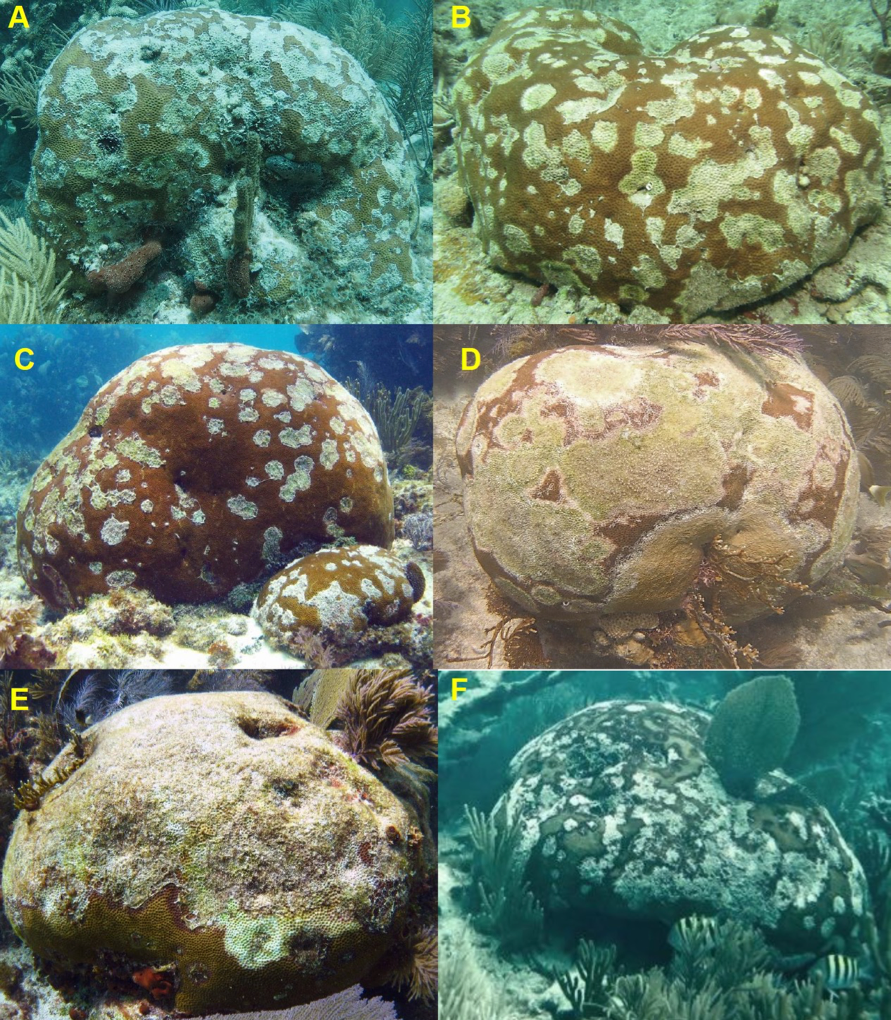In the early summer of 2015, while monitoring the coral reef communities off southeastern Florida, scientists began noticing a new coral disease affecting large colonies of the massive starlet coral Siderastrea siderea (Figure 1).
The first observations of this new disease were made in the waters of Biscayne National Park in southern Miami-Dade County (Figure 1A). In the fall of 2015 the disease was observed north of Miami near Haulover Beach, and by the spring of 2016 it was noted off Sunny Isles in northern Miami-Dade County (Figure 1B). In less than one year the disease had spread north a distance of more than 65 km. We also noted cases spreading southward against the prevailing currents, and by the early summer of 2016 it was identified at Carysfort Reef, which is located in the northern reaches of the Florida Keys National Marine Sanctuary (FKNMS).
 Figure 1. (A) Siderastrea White-Blotch Syndrome photographed off Fowey Rocks in Biscayne National Park in southern Miami-Dade County on July 12, 2015 by William Precht. (B) View of diseased Siderastrea colony taken off Sunny Isles in northern Miami-Dade County on April 5, 2016 by Sara Thanner. (C) Active disease photographed at Dry Rocks in the FKNMS on July 6, 2017 by Richard Aronson. (D) Large circular, coalescing dead patches resulting from actively expanding disease margins photographed at Carysfort Reef in the FKNMS on June 4, 2016 by Kristian Rogers. Note large blotches encircled by a zone of pinkish hyperpigmentation on remaining live coral tissue. (E) Large colony of Siderastrea with >90% mortality from white-blotch syndrome at Dry Rocks in the FKNMS on July 6, 2017. Note disease margin still active at base of colony. (F) Diseased colony observed in southern Belize in the fall of 2017 by Les Kaufman.
Figure 1. (A) Siderastrea White-Blotch Syndrome photographed off Fowey Rocks in Biscayne National Park in southern Miami-Dade County on July 12, 2015 by William Precht. (B) View of diseased Siderastrea colony taken off Sunny Isles in northern Miami-Dade County on April 5, 2016 by Sara Thanner. (C) Active disease photographed at Dry Rocks in the FKNMS on July 6, 2017 by Richard Aronson. (D) Large circular, coalescing dead patches resulting from actively expanding disease margins photographed at Carysfort Reef in the FKNMS on June 4, 2016 by Kristian Rogers. Note large blotches encircled by a zone of pinkish hyperpigmentation on remaining live coral tissue. (E) Large colony of Siderastrea with >90% mortality from white-blotch syndrome at Dry Rocks in the FKNMS on July 6, 2017. Note disease margin still active at base of colony. (F) Diseased colony observed in southern Belize in the fall of 2017 by Les Kaufman.
We coined the term “Siderastrea white-blotch syndrome” to describe this new disease. The disease presents as circular white blotches scattered across the surface of otherwise healthy-looking colonies. The blotches usually initiate as blemishes or lesions on the colony surface (Figure 1C). With time, these blotches expand in ever-widening circles of exfoliating tissue that slough off the surface of the living colony (Figure 1D). Frequently but not invariably, each blotch is encircled by a zone of purplish or pinkish hyperpigmentation due to an increased concentration of a non-fluorescent pigment (Figures 1D and 1E). Eventually, the entire colony dies, leaving behind a limestone skeleton that is subsequently fouled by encrusting algae, sediment, and invertebrates (Figure 1E). At a number of sites, we witnessed large, century-old colonies that had completely died within a few months after the initial infection was recorded. By the summer of 2017 the disease could be seen on most of the reefs in the upper Florida Keys, with devastating impact on the S. siderea population. Similar lesions affecting small Siderastrea radians colonies were observed in the shallow Gulf of Mexico off Marker 88 beach, Islamorada, Florida during the summer of 2017. Until recently S. siderea was the most abundant remaining coral species on many of these reefs after decades of coral mortality in the western Atlantic. As we write this note in early 2018, the disease is still active, progressing south through the FKNMS. Several scientists are now examining this disease syndrome using both molecular and histopathological methods, in hopes of understanding its etiology.
In the fall of 2017, while teaching a coral reef field class in southern Belize, C.A. one of us (L.K.) photographed diseased colonies of S. siderea with the same outward signs of white-blotch syndrome described above from Florida (Figure 1F). At present, it is unknown what the ecological impacts of this emerging disease will be; however, the preliminary news from the initial stages of this outbreak are disturbing. The sudden emergence, rapid progression, and high mortality caused by this newly recognized disease condition justify grave concern.
By: Lindsey Precht, Sara Thanner, Esther Peters, Kristian Rogers, Les Kaufman, Benjamin Aronson, Richard Aronson, and William Precht



